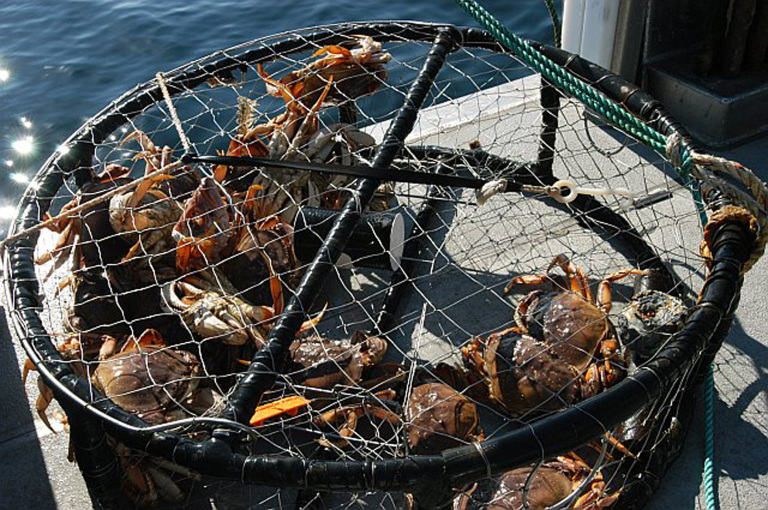
Report Date:
http://californiaoutdoorsqas.comQuestion: My family has for many years eaten fresh Dungeness Crab on Christmas Eve. We haven’t for a few years but would like to resume for this upcoming Christmas Eve. We have some doubts about eating it and were wondering if you could supply some information that would help the doubters feel comfortable eating crab again this year. (The Healy Family)
Answer: The short answer is: Ask where your crabs came from. If they came from south of the Sonoma/Mendocino county line, or what fishermen will call District 10, you should be fine to eat your Christmas Eve Dungeness crab. Anywhere north of that point is currently closed to commercial harvest so they should not be available commercially from that area.
Crabs are tested regularly for domoic acid. This year, Dungeness crab caught south of the Sonoma/Mendocino county line have tested clean (meaning they do not have elevated levels of domoic acid and should be safe). Because they are clean, the commercial season is open there and crabs that you’re likely seeing in the market are from south of that point. North of the county line, there have been some ports with higher levels of domoic acid. However, the commercial season is not closed there currently due to domoic acid. The season north of that line is closed so far because the crab quality is not sufficient for the season to start. The meat yield is not enough on the crabs.
The season for recreational crabbers is open statewide (you can’t buy these, but you could go get them yourself if you’re a fisherman and have a fishing license). However, the California Department of Public Health has issued a warning for recreational crabbers to remove the crab guts before cooking them because of those few ports that have shown crabs with high levels of domoic acid. You can read the CDPH advisory at cdph.ca.gov/Programs/OPA/Pages/NR17-079.aspx.
Hunting on private land without fencing or signage
Question: I have a question about hunting on private land. This property can be found on a map but it has zero fencing or signage stating that it’s private property and it has a forest service road cutting through it. It’s readily used for parking etc. but on all my maps it is marked private. Do I need to heed the map? It is possible the map is out of date. I was always under the impression that if there is no fencing or signage, then you are not out of bounds. (James V., San Diego)
Answer: Ethical hunters will always be careful to avoid unlawfully accessing private property — and your inquiry demonstrates the approach of an ethical hunter. To make sure the land you intend to hunt is not private, you should look at an appropriate map. There are government and private websites with maps and map-based tools that show specific parcels and their ownership. These online maps frequently offer the most up-to-date records of land ownership.
California Fish and Game Code, section 2016 states: “It is unlawful to enter land for the purpose of discharging a firearm or taking or destroying a mammal or bird, including waterfowl, on that land, without having first obtained written permission from the owner, the owner’s agent, or the person in lawful possession of that land, if either of the following is true: (a) The land belongs to or is occupied by another person and is either under cultivation or enclosed by a fence. (b) There are signs of any size and wording forbidding trespass or hunting or both displayed along all exterior boundaries of the land, at intervals not less than three to the mile, and at all roads and trails entering the land, including land temporarily inundated by water flowing outside of the established banks of a river, stream, slough, or other waterway, which fairly advise a person about to enter the land that the use of the land is so restricted.”
Although a hunter might not violate FGC 2016 by accessing private property without permission from the owner of that property, such access may still be unlawful, as a private property owner does not waive his or her rights to exclude the public from that property by failing to post “no trespassing” or “no hunting” signs. Accordingly, the California Department of Fish and Wildlife Hunter Education Handbook states, “If the land you hunt on is not your own, it belongs to someone else. Make sure you have a legal right to be there. Contact the owner or person who administers the property, and secure written permission to hunt. A hunting license does not entitle you to enter private property.”
Carrie Wilson is a marine environmental scientist with the California Department of Fish and Wildlife. While she cannot personally answer everyone’s questions, she will select a few to answer each week in this column. Please contact her at CalOutdoors@wildlife.ca.gov.Report Date:
The California Department of Fish and Wildlife (CDFW) is offering a special apprentice youth waterfowl hunt at the Grizzly Island......
Report Date:
Question: Why does the deer harvest report questionnaire ask about the number of days spent hunting? Why is this question important?......